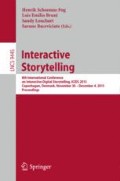Abstract
Creating serious games calls for a multidisciplinary design team, including game developers, subject-matter experts, pedagogical experts, and narrative designers. However, such multidisciplinary teams often experience communication and collaboration problems due to the different terminologies, backgrounds and concerns of the people involved. To overcome these problems, we propose the use of a Controlled Natural Language (CNL) in combination with a graphical notation for modeling game narratives. The use of a CNL provides an easy human-readable, yet flexible and expressive way to specify story-lines. In addition, a CNL provides the possibility for automatically processing story-lines and generating code. As such, incorporating CNL in the design process also contributes to shortening the development time.
Access this chapter
Tax calculation will be finalised at checkout
Purchases are for personal use only
Notes
References
De Troyer, O., Janssens, E.: Supporting the requirement analysis phase for the development of serious games for children. Int. J. Child-Comput. Interact. 2(2), 76–84 (2014)
Dobbe, J.: A Domain-Specific Language for Computer Games. Master’s thesis, TU Delft (2004)
Dondlinger, M.: Educational video game design: a review of the literature. J. Appl. Educ. Technol. 1(4), 21–31 (2007)
Friendly ATTAC. http://www.friendlyattac.be/en/
Fuchs, N.E., Schwertel, U., Schwitter, R.: Attempto Controlled English – not just another logic specification language. In: Flener, P. (ed.) Logic-Based Program Synthesis and Transformation. Lecture Notes in Computer Science, vol. 1559, p. 1. Springer, Heidelberg (1999)
Furtado, A.W., Santos, A.L.: Using domain-specific modeling towards computer games development industrialization. In: The 6th OOPSLA Workshop on Domain-Specific Modeling (DSM06) (2006)
Guerreiro, R., Rosa, A., Sousa, V., Amaral, V., Correia, N.: Ubilang: towards a domain specific modeling language for specification of ubiquitous games. In: INForum, pp. 449–460 (2010)
Kuhn, T.: A survey and classification of controlled natural languages. Comput. Linguist. 40(1), 121–170 (2014)
Lindley, C.A.: Story and narrative structures in computer games (2005)
Tolvanen, J.-P., Kelly, S.: Defining domain-specific modeling languages to automate product derivation: collected experiences. In: Obbink, H., Pohl, K. (eds.) Software Product Lines. Lecture Notes in Computer Science, vol. 3714, pp. 198–209. Springer, Heidelberg (2005)
Maloney, J., Burd, L., Kafai, Y., Rusk, N., Silverman, B., Resnick, M.: Scratch: a sneak preview. In: 2004 Proceedings of Second International Conference on Creating, Connecting and Collaborating through Computing, pp. 104–109. IEEE (2004)
Marchiori, E., Torrente, J., del Blanco, Á., Moreno-Ger, P., Fernández-Manjón, B.: A visual domain specific language for the creation of educational video games. IEEE Learn. Technol. Newslett. 12(1), 36–39 (2010)
Van Broeckhoven, F., De Troyer, O.: ATTAC-L: A Domain Specific Modeling Language for Defining Virtual Experience Scenarios in the Context of Cyber-bullying Prevention - Version 2. Vrije Universiteit Brussel, technical report (2012)
Van Broeckhoven, F., De Troyer, O.: ATTAC-L: a modeling language for educational virtual scenarios in the context of preventing cyber bullying. In: 2nd International Conference on Serious Games and Applications for Health, pp. 1–8. IEEE, May 2013
Van Broeckhoven, F., De Troyer, O.: Specifying the pedagogical aspects of narrative-based digital learning games using annotations. In: Proceedings of the 9th International Conference on the Foundations of Digital Games. Society for the Advancement of the Science of Digital Games (2014)
Van Broeckhoven, F., Vlieghe, J., De Troyer, O.: Mapping between pedagogical design strategies and serious game narratives. In: Proceedings of the 7th International Conference on Games and Virtual Worlds for Serious Applications (VS-Games). IEEE (2015)
Van Deursen, A., Klint, P., Visser, J.: Domain-specific languages: an annotated bibliography. Sigplan Not. 35(6), 26–36 (2000)
Author information
Authors and Affiliations
Corresponding author
Editor information
Editors and Affiliations
Rights and permissions
Copyright information
© 2015 Springer International Publishing Switzerland
About this paper
Cite this paper
Van Broeckhoven, F., Vlieghe, J., De Troyer, O. (2015). Using a Controlled Natural Language for Specifying the Narratives of Serious Games. In: Schoenau-Fog, H., Bruni, L., Louchart, S., Baceviciute, S. (eds) Interactive Storytelling. ICIDS 2015. Lecture Notes in Computer Science(), vol 9445. Springer, Cham. https://doi.org/10.1007/978-3-319-27036-4_13
Download citation
DOI: https://doi.org/10.1007/978-3-319-27036-4_13
Published:
Publisher Name: Springer, Cham
Print ISBN: 978-3-319-27035-7
Online ISBN: 978-3-319-27036-4
eBook Packages: Computer ScienceComputer Science (R0)

